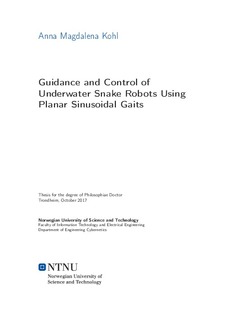| dc.description.abstract | This thesis presents different approaches for guidance and motion control of underwater snake robots. The robots considered in this thesis are neutrally buoyant and move slowly with a planar, biologically inspired sinusoidal gait. The proposed guidance systems are designed such that they can reject environmental disturbances by an ocean current or avoid collision with stationary obstacles. The control approaches developed in this thesis are model-based, which enables formal stability analyses.
As a basis for the development of model-based control methods and in order to create a fundamental understanding of underwater snake robot locomotion, one chapter of this thesis deals with modelling and locomotion analysis of underwater snake robots. More specifically, two models are presented for underwater snake robots that move in a plane. The first one is based on first principles and formalized using Newton-Euler equations. Based on this model, an analysis of planar sinusoidal locomotion is presented, revealing several fundamental properties. These properties allow some simplifying assumptions, based on which the second, control-oriented model is derived. The two models are compared in an extensive simulation study, where the advantages and limitations of the simplified controloriented model become clear. The chapter is concluded by an averaging analysis of the velocity dynamics of the control-oriented model during sinusoidal gaits.
In the subsequent chapters, two approaches for guidance and motion control of underwater snake robots are developed. The first one is based on the controloriented model and employs a sinusoidal gait to achieve a positive velocity without a velocity feedback controller in the inner control loop. As an outer control loop, a model-based orientation controller is designed, which steers the robot towards and along a straight path in the presence of unknown ocean currents. This is achieved by employing an integral line-of-sight guidance law. The control system is experimentally validated and the origin of the error dynamics is shown to be uniformly semi-globally exponentially stable using cascaded systems theory. The second approach for guidance and motion control is based on the original, more complex model and employs a manoeuvring controller that considers both heading and velocity control, and enables the robot to follow a generic path. It is an extension of a similar method for terrestrial snake robots, that was formally shown to practically stabilize the states to their references. The proposed feedback control strategy enforces virtual constraints on the snake robot configuration. The constraints encode biologically inspired gaits and are parametrized by states of dynamic compensators that are used to regulate the heading and forward velocity of the snake robot. Inorder to adapt the control approach for underwater robots, a two-state ocean current observer, based on relative velocity sensors, is proposed. It enables the robot to achieve its path-following control objectives in the presence of ocean currents. The efficacy of the proposed control algorithm is verified for several biologically inspired gaits both in simulations for different path geometries, and in experiments.
The control approaches described above both rely on the availability of relative velocity measurements. In an additional chapter, this thesis presents a method for orientation and velocity control of a robot that has access to absolute velocity measurements instead. This controller also utilizes virtual constraints in order to impose a sinusoidal gait on the body shape of the robot and is based on an adaptive backstepping design. A stability analysis is presented, where it is shown that joint and velocity control objectives are guaranteed to be satisfied, and further analysis challenges are outlined. The findings are illustrated with simulations.
Finally, a guidance strategy for path-following with obstacle avoidance for underwater snake robots is presented. The guidance strategy is an adaptation of a guidance system for surface vessels, that consists of two modes, path-following mode and obstacle avoidance mode. The guidance scheme is made suitable for snake robots by introducing a new, purely kinematic switching condition It is shown that the guidance strategy guarantees obstacle avoidance for non-overlapping obstacles, which is in addition validated experimentally. | |
